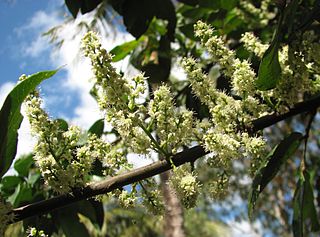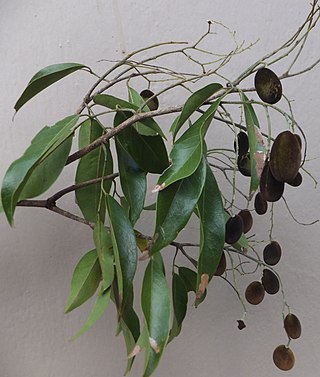
The International Union for Conservation of Nature (IUCN) Red List of Threatened Species, also known as the IUCN Red List or Red Data Book, founded in 1964, is an inventory of the global conservation status and extinction risk of biological species. A series of Regional Red Lists, which assess the risk of extinction to species within a political management unit, are also produced by countries and organizations.

The macaques constitute a genus (Macaca) of gregarious Old World monkeys of the subfamily Cercopithecinae. The 23 species of macaques inhabit ranges throughout Asia, North Africa, and Europe. Macaques are principally frugivorous, although their diet also includes seeds, leaves, flowers, and tree bark. Some species such as the long-tailed macaque will supplement their diets with small amounts of meat from shellfish, insects, and small mammals. On average, a southern pig-tailed macaque in Malaysia eats about 70 large rats each year. All macaque social groups are arranged around dominant matriarchs.
The conservation status of a group of organisms indicates whether the group still exists and how likely the group is to become extinct in the near future. Many factors are taken into account when assessing conservation status: not simply the number of individuals remaining, but the overall increase or decrease in the population over time, breeding success rates, and known threats. Various systems of conservation status are in use at international, multi-country, national and local levels, as well as for consumer use such as sustainable seafood advisory lists and certification. The two international systems are by the International Union for Conservation of Nature (IUCN) and The Convention on International Trade in Endangered Species of Wild Fauna and Flora (CITES).

Guioa is a genus of about 78 rainforest tree species known to science, which constitute part of the plant family Sapindaceae. They have a wide distribution, ranging from throughout Malesia, in Burma, Cambodia, Vietnam, Thailand, Malay Peninsula, Borneo, Sumatra, Philippines, Java, Flores, Timor, Sulawesi, Moluccas, New Guinea, further southwards through the east coast of Queensland and New South Wales, Australia and further eastwards to the Pacific Islands, including Tonga, New Caledonia, Fiji and Samoa.

A genet is a member of the genus Genetta, which consists of 17 species of small African carnivorans. The common genet is the only genet present in Europe and occurs in the Iberian Peninsula, Italy and France.

A species that is extinct in the wild (EW) is one that has been categorized by the International Union for Conservation of Nature as only consisting of living members kept in captivity or as a naturalized population outside its historic range. Classification requires exhaustive surveys conducted within the species' known habitat with consideration given to seasonality, time of day, and life cycle. Once a species is classified as EW, the only way for it to be downgraded is through reintroduction.

Dialium is a genus of flowering plants in the family Fabaceae, subfamily Dialioideae. Velvet tamarind is a common name for several species. The genus includes 37 species which range from the tropical Americas to sub-Saharan Africa, Madagascar, India, Indochina, and western Malesia.

Dialium cochinchinense, the velvet tamarind, is a species of flowering plant in the family Fabaceae. It is native to Borneo and Indochina, but may have been introduced to Sri Lanka, Ghana, Nigeria and other west African countries.. In the wild, it is threatened by habitat loss.
Dialium lopense is a species of legume in the family Fabaceae. It is endemic to Gabon. It is threatened by habitat loss.
Dialium orientale is a species of plant in the family Fabaceae.It is found in Kenya, Somalia, and Tanzania. The fruit of this tree is a popular snack in Kenya and known as pepeta. It is threatened by habitat loss.
Dialium travancoricum is a critically endangered species of plant in the family Fabaceae. It is found only in Kerala India specifically around the Travancore range near Ponmudi and Ariankavu. It is threatened by habitat loss.

Loxococcus rupicola is a species of palm tree, and the only species in the genus Loxococcus. It is endemic to Sri Lanka. It is threatened by habitat loss.

Helicia is a genus of 110 species of trees and shrubs, constituting part of the plant family Proteaceae. They grow naturally in rainforests throughout tropical South and Southeast Asia, including India, Sri Lanka, Indochina, Peninsular Malaysia to New Guinea and as far south as New South Wales.

A vulnerable species is a species which has been categorized by the International Union for Conservation of Nature as being threatened with extinction unless the circumstances that are threatening its survival and reproduction improve.

Dialium guineense, the velvet tamarind, is a tall, tropical, fruit-bearing tree in the family Fabaceae. It has small, typically grape-sized, edible fruits with brown, hard, inedible shells.

Angraecum podochiloides is a species of comet orchid that can be found in Cameroon, the Democratic Republic of the Congo, Côte d'Ivoire, Equatorial Guinea, Gabon, Ghana, Liberia and Nigeria. It can be found in dense lowland forests on Gilbertiodendron dewevrei, and in humid forests at higher elevations or low montane forests. It is an epiphyte on Dialium corbisieri or in periodically flooded marshes with Guibourtia.

Endangered species, as classified by the International Union for Conservation of Nature (IUCN), are species which have been categorized as very likely to become extinct in their known native ranges in the near future. On the IUCN Red List, endangered is the second-most severe conservation status for wild populations in the IUCN's schema after critically endangered. In 2012, the IUCN Red List featured 3,079 animal and 2,655 plant species as endangered worldwide. The figures for 1998 were 1,102 and 1,197 respectively.
Dialium polyanthum is a species of flowering plant, a medium to large tree in the family Fabaceae, subfamily Dialioideae.
Du Chaillu's rope squirrel is a species of rodent in the family Sciuridae. It is endemic to parts of central Gabon, within dense tropical rainforests, where it was listed as extinct in 1952, but was then rediscovered in 1993. The species is currently has a "Data Deficient" conservation status brought about by the IUCN Red List. It was named after French zoologist, traveler, and anthropologist Paul Du Chaillu.













